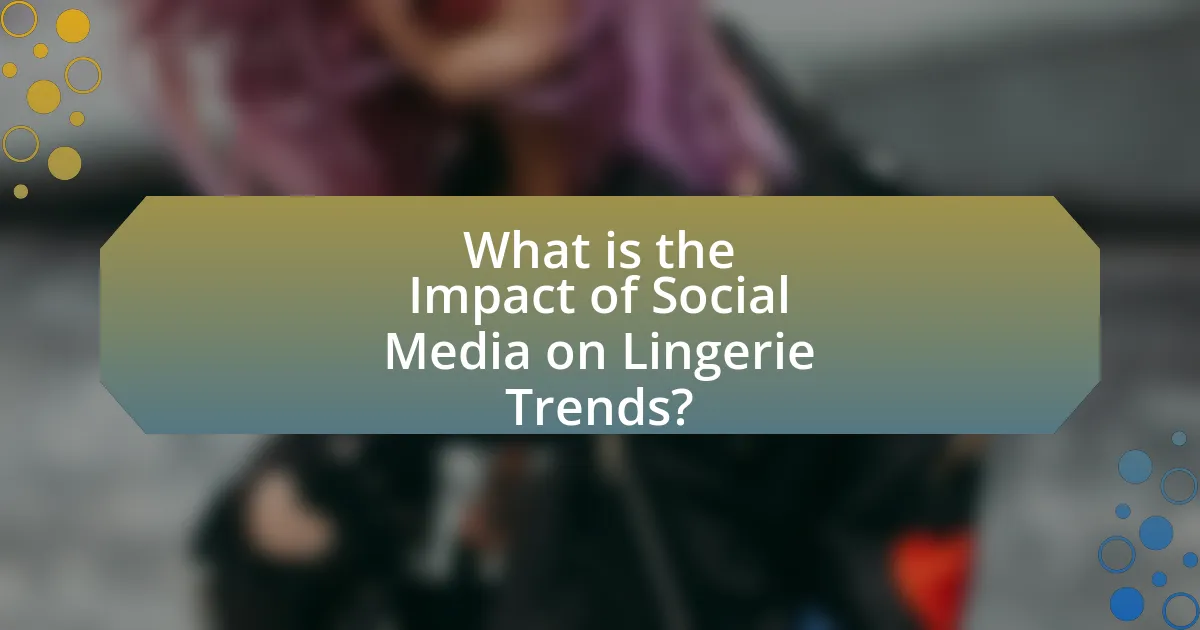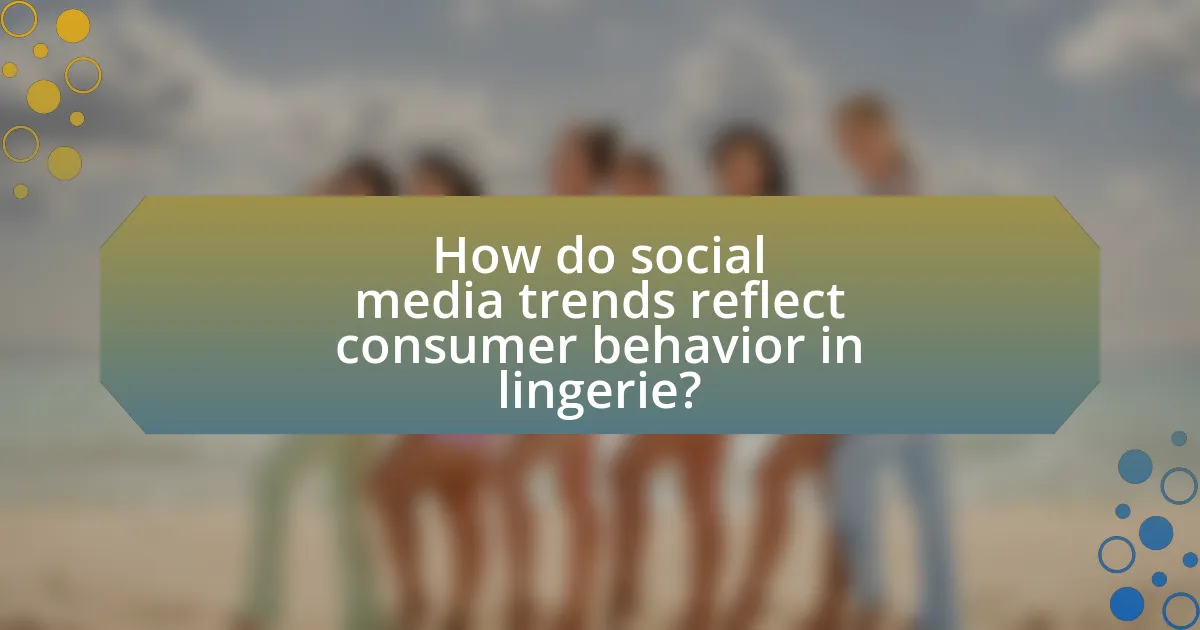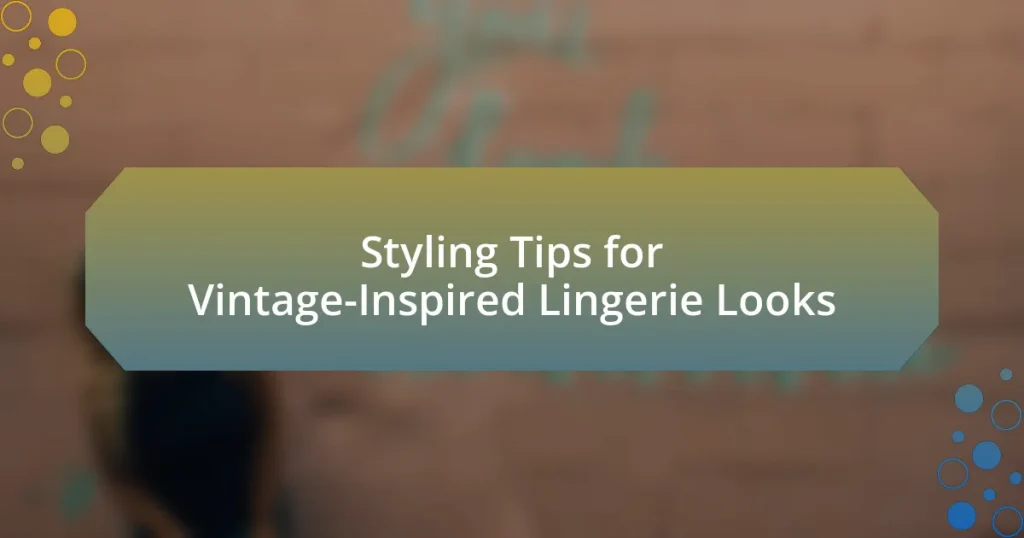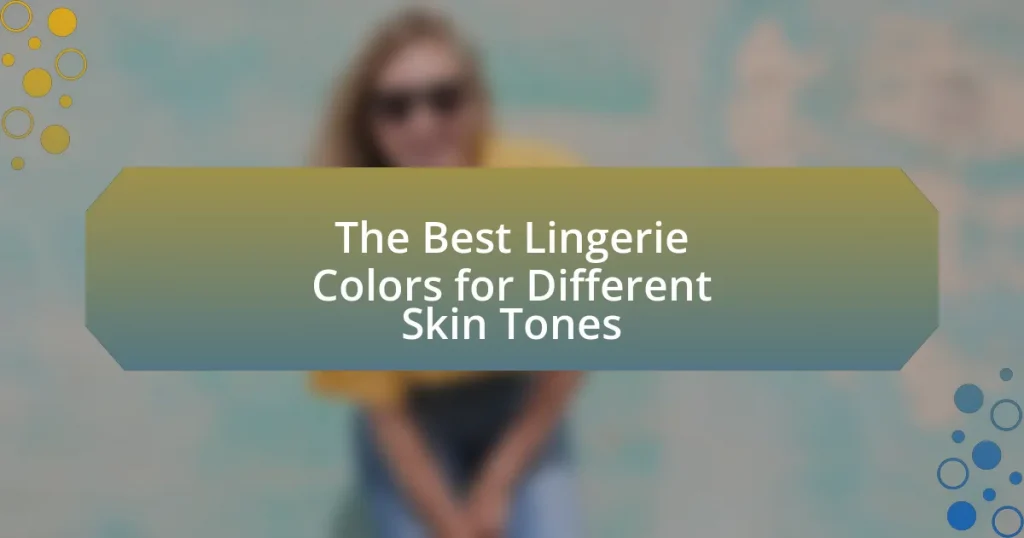The article examines the significant impact of social media on lingerie trends, highlighting how platforms like Instagram and TikTok shape consumer preferences and enhance brand visibility. It discusses the transformation of lingerie marketing through direct consumer engagement, the influence of user-generated content and influencers, and the importance of inclusivity and body positivity in current trends. Additionally, the article addresses the challenges lingerie brands face due to social media dynamics, including competition and consumer expectations, while outlining effective strategies for leveraging social media to foster brand loyalty and drive sales.

What is the Impact of Social Media on Lingerie Trends?
Social media significantly influences lingerie trends by shaping consumer preferences and driving brand visibility. Platforms like Instagram and TikTok allow brands to showcase their products through visually appealing content, leading to increased engagement and sales. For instance, a study by the NPD Group found that social media marketing has contributed to a 20% increase in lingerie sales among millennials and Gen Z consumers. Additionally, user-generated content and influencer partnerships create a sense of authenticity, encouraging consumers to embrace diverse body types and styles, which has led to a rise in inclusive lingerie lines.
How has social media changed the way lingerie is marketed?
Social media has transformed lingerie marketing by enabling brands to engage directly with consumers through targeted advertising and influencer partnerships. This shift allows for real-time feedback and interaction, fostering a community around lingerie brands. For instance, platforms like Instagram and TikTok have become essential for showcasing products through visually appealing content, leading to increased brand visibility and consumer interest. According to a 2021 survey by Statista, 54% of consumers reported discovering new lingerie brands through social media, highlighting its effectiveness in reaching potential customers.
What platforms are most influential in shaping lingerie trends?
Social media platforms such as Instagram, TikTok, and Pinterest are the most influential in shaping lingerie trends. Instagram, with over 1 billion monthly active users, serves as a visual platform where brands and influencers showcase new styles, driving consumer interest and engagement. TikTok’s short-form video content allows for viral trends to emerge rapidly, influencing younger demographics and encouraging spontaneous purchases. Pinterest acts as a discovery tool, where users curate boards that reflect their personal style, including lingerie preferences, thus impacting purchasing decisions. These platforms collectively create a dynamic environment that continuously evolves lingerie trends through user interaction and content sharing.
How do influencers affect consumer perceptions of lingerie?
Influencers significantly shape consumer perceptions of lingerie by leveraging their social media platforms to showcase products in relatable and aspirational contexts. Their endorsements often create a sense of trust and authenticity, leading consumers to view the lingerie as desirable and fashionable. Research indicates that 49% of consumers depend on influencer recommendations when making purchase decisions, highlighting the persuasive power of influencers in the lingerie market. Additionally, influencers often promote body positivity and inclusivity, which can alter traditional perceptions of lingerie, making it more accessible and appealing to a broader audience.
What role does user-generated content play in lingerie trends?
User-generated content significantly influences lingerie trends by shaping consumer perceptions and driving brand engagement. This content, often shared on social media platforms, allows consumers to showcase their personal styles and preferences, which in turn informs brands about emerging trends and customer desires. For instance, a study by the NPD Group found that 70% of consumers are influenced by peer recommendations and user-generated images when making purchasing decisions in fashion, including lingerie. This highlights the power of authentic consumer voices in dictating market trends and fostering a sense of community around lingerie brands.
How does customer feedback on social media influence lingerie designs?
Customer feedback on social media significantly influences lingerie designs by providing brands with real-time insights into consumer preferences and trends. This feedback allows designers to understand what styles, materials, and features resonate with their target audience, leading to more tailored and appealing products. For instance, a study by McKinsey & Company found that brands leveraging customer insights can increase their sales by up to 20%. Additionally, social media platforms enable direct interaction between consumers and brands, allowing for immediate adjustments in design based on customer reactions and suggestions. This responsiveness not only enhances customer satisfaction but also fosters brand loyalty, as consumers feel their opinions are valued in the design process.
What are the implications of social media reviews for lingerie brands?
Social media reviews significantly influence lingerie brands by shaping consumer perceptions and purchasing decisions. Positive reviews can enhance brand reputation and drive sales, as 79% of consumers trust online reviews as much as personal recommendations. Conversely, negative reviews can damage a brand’s image and lead to decreased sales, with 94% of consumers stating that a negative review has convinced them to avoid a business. Additionally, lingerie brands must actively engage with customer feedback on social media to build trust and loyalty, as brands that respond to reviews can improve customer satisfaction and retention.
Why is social media important for lingerie brands today?
Social media is crucial for lingerie brands today because it provides a platform for direct engagement with consumers, enhancing brand visibility and customer loyalty. With over 4.5 billion active social media users globally, lingerie brands can showcase their products, share user-generated content, and create targeted advertising campaigns that resonate with specific demographics. For instance, brands like Savage X Fenty have successfully utilized social media to promote inclusivity and body positivity, resulting in increased sales and brand recognition. Additionally, social media analytics allow brands to track consumer preferences and trends in real-time, enabling them to adapt their marketing strategies effectively.
How do brands leverage social media for brand awareness?
Brands leverage social media for brand awareness by creating engaging content that resonates with their target audience, utilizing platforms like Instagram and TikTok to showcase their products visually. This approach allows brands to reach a wider audience, as social media facilitates sharing and interaction, leading to increased visibility. For instance, a study by Sprout Social found that 70% of consumers are more likely to purchase from a brand they follow on social media, highlighting the effectiveness of these platforms in driving brand recognition and loyalty. Additionally, brands often collaborate with influencers to tap into their followers, further amplifying their reach and credibility.
What strategies do successful lingerie brands use on social media?
Successful lingerie brands utilize targeted influencer partnerships, engaging visual content, and community-driven campaigns on social media. These strategies enhance brand visibility and foster customer loyalty. For instance, brands like Victoria’s Secret and Savage X Fenty collaborate with influencers who resonate with their target demographics, effectively reaching wider audiences. Engaging visual content, such as high-quality images and videos showcasing products in real-life scenarios, captures consumer attention and drives engagement. Additionally, community-driven campaigns, like user-generated content and interactive polls, encourage customer participation and create a sense of belonging, which is crucial in the lingerie market. These approaches have been shown to increase brand engagement and sales, as evidenced by the significant growth in social media-driven purchases in the fashion industry.

How do social media trends reflect consumer behavior in lingerie?
Social media trends reflect consumer behavior in lingerie by showcasing preferences for body positivity, inclusivity, and diverse styles. Platforms like Instagram and TikTok amplify these trends, as users share personal experiences and preferences, influencing purchasing decisions. For instance, a study by McKinsey & Company found that 70% of consumers are influenced by social media when making fashion purchases, including lingerie. This indicates that social media not only shapes consumer preferences but also drives sales through visual engagement and community-driven content.
What are the current trends in lingerie as seen on social media?
Current trends in lingerie as seen on social media include a focus on inclusivity, body positivity, and sustainability. Brands are increasingly showcasing diverse body types and sizes, reflecting a broader societal shift towards acceptance and representation. For instance, campaigns featuring models of various shapes and ethnicities have gained traction, with brands like Savage X Fenty leading the way. Additionally, eco-friendly materials and ethical production practices are becoming more prominent, as consumers express a preference for sustainable options. According to a report by McKinsey & Company, 67% of consumers consider sustainability when making fashion purchases, highlighting the growing importance of this trend in the lingerie market.
How do seasonal trends manifest in social media lingerie posts?
Seasonal trends in social media lingerie posts manifest through variations in color palettes, styles, and promotional campaigns aligned with holidays and seasonal events. For instance, during winter, posts often feature darker, richer colors and cozy fabrics, while summer showcases lighter materials and vibrant hues. Additionally, brands leverage events like Valentine’s Day and Christmas to launch themed collections, which are heavily promoted on platforms like Instagram and TikTok, driving engagement and sales. Data from a 2022 study by Statista indicates that lingerie sales peak around these holidays, reflecting the influence of seasonal trends on consumer behavior in social media marketing.
What styles are gaining popularity through social media platforms?
Lingerie styles gaining popularity through social media platforms include bralettes, high-waisted panties, and sustainable lingerie. Bralettes have surged in popularity due to their comfort and versatility, often showcased by influencers on platforms like Instagram and TikTok. High-waisted panties are favored for their retro appeal and flattering fit, frequently highlighted in fashion posts and videos. Sustainable lingerie is increasingly sought after as consumers become more environmentally conscious, with brands promoting eco-friendly materials and ethical production practices through social media campaigns. These trends reflect the evolving preferences of consumers influenced by visual content and peer recommendations on social media.
How does social media influence body positivity in lingerie marketing?
Social media significantly influences body positivity in lingerie marketing by promoting diverse body representations and fostering inclusive conversations. Platforms like Instagram and TikTok allow brands to showcase models of various sizes, shapes, and ethnicities, challenging traditional beauty standards. For instance, campaigns by brands such as Aerie and Savage X Fenty have gained traction by featuring unretouched images and a wide range of body types, which resonate with consumers seeking authenticity. Research indicates that 67% of women feel more confident when they see diverse body types in advertising, highlighting the positive impact of social media on body image perceptions.
What campaigns have successfully promoted body diversity in lingerie?
A notable campaign that has successfully promoted body diversity in lingerie is Aerie’s #AerieREAL campaign. Launched in 2014, this initiative features unretouched photos of models of various body types, emphasizing authenticity and inclusivity. The campaign has led to a significant increase in sales, with Aerie reporting a 20% growth in revenue in 2019, showcasing the positive consumer response to body diversity. Another impactful campaign is Savage X Fenty’s annual fashion show, which highlights a wide range of body shapes, sizes, and ethnicities, further normalizing diversity in lingerie. This approach has garnered critical acclaim and increased brand visibility, demonstrating the effectiveness of inclusive marketing strategies in the lingerie industry.
How do social media movements impact consumer expectations of lingerie brands?
Social media movements significantly shape consumer expectations of lingerie brands by promoting inclusivity, body positivity, and transparency. These movements, such as #MeToo and #BodyPositivity, have led consumers to demand that lingerie brands represent diverse body types and prioritize ethical manufacturing practices. For instance, a survey by the lingerie brand ThirdLove found that 70% of women feel more empowered to express their body image through brands that embrace diversity. Consequently, brands that fail to align with these social values risk losing consumer loyalty and market share.

What challenges do lingerie brands face due to social media trends?
Lingerie brands face significant challenges due to social media trends, primarily including heightened competition, rapid consumer expectations, and issues related to body image representation. The proliferation of social media platforms has intensified competition as numerous brands vie for consumer attention, making it difficult for individual brands to stand out. Additionally, social media accelerates consumer expectations for new styles and trends, requiring brands to frequently update their offerings to remain relevant. Furthermore, the portrayal of body image on social media can lead to unrealistic standards, pressuring lingerie brands to diversify their marketing strategies and product lines to cater to a broader range of body types. These challenges necessitate that lingerie brands adapt quickly to maintain market relevance and consumer trust.
How do negative social media perceptions affect lingerie brands?
Negative social media perceptions significantly harm lingerie brands by damaging their reputation and reducing consumer trust. When negative comments or reviews proliferate online, they can lead to decreased sales, as potential customers may be deterred by the unfavorable image. For instance, a study by Sprout Social found that 86% of consumers read reviews before making a purchase, indicating that negative perceptions can directly influence buying decisions. Additionally, brands may experience a decline in engagement and loyalty, as consumers gravitate towards competitors perceived more favorably. This impact is compounded by the viral nature of social media, where negative sentiments can spread rapidly, amplifying their effect on brand perception and market performance.
What are the risks of backlash from social media campaigns?
The risks of backlash from social media campaigns include damage to brand reputation, loss of customer trust, and potential financial repercussions. When a campaign is perceived as insensitive or controversial, it can lead to public outrage, resulting in negative media coverage and social media criticism. For instance, a study by the Pew Research Center found that 41% of social media users have unfollowed a brand due to its controversial posts. This backlash can diminish customer loyalty and lead to decreased sales, as consumers increasingly prefer brands that align with their values.
How can brands mitigate negative feedback on social media?
Brands can mitigate negative feedback on social media by actively engaging with customers, addressing concerns promptly, and demonstrating transparency. Engaging with customers allows brands to acknowledge issues and show that they value feedback, which can help to rebuild trust. Addressing concerns promptly is crucial; research indicates that 70% of consumers expect a response within 24 hours, and timely responses can significantly reduce the impact of negative comments. Transparency in communication, such as admitting mistakes and outlining corrective actions, fosters a positive brand image and encourages customer loyalty.
What are the best practices for lingerie brands on social media?
Lingerie brands should prioritize authenticity, engagement, and visual storytelling on social media. Authenticity builds trust; brands like Aerie have successfully used unretouched images to resonate with their audience, leading to a 20% increase in sales. Engagement is crucial; responding to comments and messages fosters community, as seen with brands like Savage X Fenty, which actively interacts with followers. Visual storytelling enhances brand identity; using high-quality images and videos that reflect the brand’s aesthetic can increase user interaction, with studies showing that posts with visuals receive 94% more views. These practices collectively enhance brand loyalty and drive sales in the competitive lingerie market.
How can brands effectively engage with their audience on social media?
Brands can effectively engage with their audience on social media by creating authentic, interactive content that resonates with their target demographic. This approach includes utilizing user-generated content, responding promptly to comments and messages, and leveraging storytelling to build emotional connections. Research indicates that brands that actively engage with their audience see a 20-40% increase in customer loyalty and brand perception, as highlighted in a study by Sprout Social, which found that 70% of consumers feel more connected to brands that engage with them on social media.
What content strategies work best for promoting lingerie on social media?
Visual storytelling is the most effective content strategy for promoting lingerie on social media. High-quality images and videos showcasing the products in aesthetically pleasing settings engage audiences and highlight the lingerie’s design and fit. According to a study by HubSpot, posts with images receive 94% more views than those without, emphasizing the importance of visual content in attracting attention. Additionally, user-generated content, such as customer photos and testimonials, fosters authenticity and trust, as 79% of consumers say user-generated content highly impacts their purchasing decisions, according to a report by Nielsen. Engaging influencers to model and promote lingerie can also expand reach, as influencer marketing generates 11 times the ROI compared to traditional advertising, according to a study by TapInfluence. These strategies collectively enhance brand visibility and consumer engagement on social media platforms.
What tips can lingerie brands implement to thrive in the social media landscape?
Lingerie brands can thrive in the social media landscape by leveraging user-generated content, engaging with their audience, and utilizing targeted advertising. User-generated content, such as customer photos and reviews, fosters authenticity and trust, which are crucial in the lingerie market where personal experience matters. Engaging with the audience through interactive posts, polls, and direct responses enhances brand loyalty and community building. Targeted advertising on platforms like Instagram and Facebook allows brands to reach specific demographics effectively, increasing conversion rates. According to a study by Hootsuite, 54% of social media users use these platforms to research products, highlighting the importance of a strong social media presence for lingerie brands.















